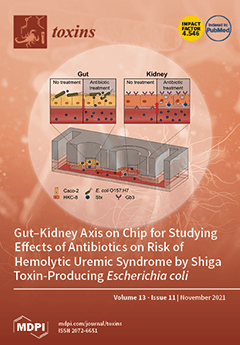The presence of
Alternaria toxins (
ATs) in fruit purees may cause potential harm to the life and health of consumers. As time passes,
ATs have become the key detection objects in this kind of food. Based on this, a novel and rapid method was established in this paper for the simultaneous detection of seven
ATS (tenuazonic acid, alternariol, alternariol monomethyl ether, altenuene, tentoxin, altenusin, and altertoxin I) in mixed fruit purees using ultra-high performance liquid chromatography-tandem mass spectrometry. The sample was prepared using the modified QuEChERS (quick, easy, cheap, effective, rugged, and safe) method to complete the extraction and clean-up steps in one procedure. In this QuEChERS method, sample was extracted with water and acetonitrile (1.5% formic acid), then salted out with NaCl, separated on an ACQUITY UPLC BEH C
18 with gradient elution by using acetonitrile and 0.1% formic acid aqueous as eluent, and detected by UPLC-MS/MS under positive (ESI
+) and negative (ESI
−) electrospray ionization and MRM models. Results showed that the seven
ATs exhibited a good linearity in the concentration range of 0.5–200 ng/mL with
R2 > 0.9925, and the limits of detection (LODs) of the instrument were in the range of 0.18–0.53 μg/kg. The average recoveries ranged from 79.5% to 106.7%, with the relative standard deviations (RSDs) no more than 9.78% at spiked levels of 5, 10, and 20 μg/kg for seven
ATs. The established method was applied to the determination and analysis of the seven
ATs in 80 mixed fruit puree samples. The results showed that
ATs were detected in 31 of the 80 samples, and the content of
ATs ranged from 1.32 μg/kg to 54.89 μg/kg. Moreover, the content of TeA was the highest in the detected samples (23.32–54.89 μg/kg), while the detection rate of Ten (24/31 samples) was higher than the other
ATs. Furthermore, the other five
ATs had similar and lower levels of contamination. The method established in this paper is accurate, rapid, simple, sensitive, repeatable, and stable, and can be used for the practical determination of seven
ATs in fruit puree or other similar samples. Moreover, this method could provide theory foundation for the establishment of limit standard of
ATs and provide a reference for the development of similar detection standard methods in the future.
Full article






